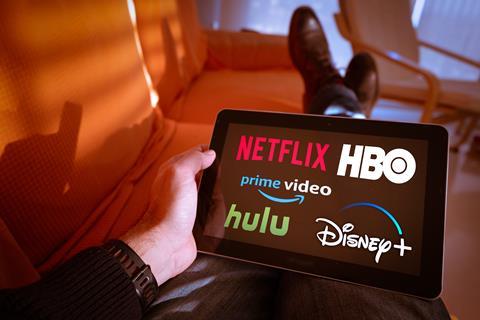As streaming video on-demand services gain traction with global audiences and media giants segueing into the market, Alana Foster looks at the state of the OTT landscape.

The streaming wars are kicking off and in an era of golden storytelling, audiences have a smorgasbord of choice when it comes to film and TV with more platform options than ever before.
As Apple readies for the launch of Apple TV+, a stronger and revamped video service which somewhat mirrors the strategy of its established rivals, the new platform has been sold as a one-stop destination for consumers to select live TV, on-demand as well as Apple original content.
The service will include access to fan favourite channels including HBO, Showtime and Starz and CEO Tim Cook is confident consumers will pursue Apple with the growing trend that is seeing audiences shift from cable packages to OTT.
Meanwhile, WarnerMedia has revealed its plans for a US launch and the full effect of Disney’s acquisition of Fox has been finalised with its sale of the Yes Network to an investor group made up of Amazon, Sinclair Broadcast Group and the Yankees which acquired the network last month in a 80% deal valued at $3.47 billion.
NBC Universal is expected to join the fray with an ad-supported service to launch in 2020 that will offer library content, licensed material and original programming to its pay-TV subscribers in the US and other markets.
It is set to be available to its 52 million cable subscribers from parent Comcast as well as on the European services of Comcast’s $39 billionn acquisition of Sky.
Reports also suggest that Viacom could become another entrant after launching a direct-to-consumer (D2C) service on the back of Pluto TV, the US free streaming service it bought in January this year for $340 million.
On the growth of the sector, Futuresource principal analyst David Sidebottom told IBC365: “We have seen the subscription video on demand sector enter a new era in 2019, with the rise of new wave D2C services.
“Scale will be key in the D2C space, but clearly the coming year is just the first phase in this era. D2C services will likely evolve, with their parent companies continuing to evaluate the benefits of D2C vs third party agreements.
“This will be particularly the case as services expand on an international basis, where legacy agreements, existing scale distribution partners and differing levels of SVOD uptake will be factors in their evolving D2C strategy.”
The monetisation issue
The new entrants are strong on paper, but there are big questions hanging over the potential growth of the sector. Do audiences want endless services and, perhaps more pertinent, will they pay?
Netflix has done a great job establishing itself as the leader in the market, but more and more content and media owners have said they will pull their content from its offering in a move to lure audiences and revenues streams back to these new services.
This is certainly true for the likes of Friends, The Office and Fresh Prince of Bel Air to name a few, with more no doubt likely to follow. What does the entrance of new players in the global streaming video on-demand (SVoD) landscape mean for the established players?
Disney owns some of the most popular and valuable content in the entertainment world, which gives it a major advantage over its rivals but how deep are consumers pockets?
The key is content and with Disney’s service boasting more than 500 movies and 7,500 episodes of current and past TV programmes it doesn’t quite match Netflix’s catalogue of 4,000 movies and 47,000 TV shows, so it has bet on audiences trading in Netflix for their favourite franchises.
Race to one billion
According to findings by Digital TV Research, subscriptions to SVoD services will increase by 439 million between 2018 and 2024 to reach 947 million, with the total climbing by 119 million in 2019 alone.
It estimated that SVoD subs will reach nearly one billion within the next five years with the US and China leading the charge.
Digital TV Research principal analyst Simon Murray said: “China overtook the US in 2018 to become the gross SVoD subscription leader. These two countries will continue to dominate the world stage.
“China and the US will together account for 59% of the global total by 2024. However, this proportion is down from 63% in 2018, indicating that other countries are growing faster.”
By 2024, it is estimated that Netflix contribute 203 million subscribers or 21% of the global total, with Amazon Prime Video’s 125 million accounting for 13% and Disney+ on 75 million, while 255 million will subscribe to a variety of other available services.
Monopolising the market
There is also a lot variance by market. A study commissioned by business-to-consumer digital services monetisation company Vindicia from N Screen Media, examined consumer relationships with streaming SVoD services.
Some 70% of US households have at least one subscription, compared with 40% of UK homes.
The report found on average the US subscriber watches 3.4 services and pays an average of $8.53 per month.
The study found the top reason people stay loyal to a service is based on the interesting content.
Clearly the demand is there from commissioning to delivery, the landscape has undergone a digital transformation and audiences are at the core of disruption.
- Read more: Digital warfare: Audiences and alliances
Interestingly, nearly nine million US Netflix subscribers said they are likely to drop the popular SVoD service in favour of Disney’s offering, according to a survey from Streaming Observer.
The survey found more than 12.3% of respondents – 602 male and female Netflix customers in the US – “might cancel Netflix and get Disney,” for the cheaper price and varied content options.
It might seem unlikely because of Netflix’s robust library but Disney is shaping up to be a competitive offering from its vast content selection, pricing and streaming options, which include ESPN and Hulu bundles.
Last week UK TV production revenue surpassed £3 billion for the first time since 2018, with SVoD revenues accounting for a total of 40% of all international profits, according to the latest Census figures from trade body Pact.
This increase is more than 10% from the previous year, and between 2012 and 2018 revenues have grown by over £500 million, which according to Pact’s annual review of the TV landscape accounts the growth rate of 3.1% per year.
Britsh-made TV shows including The Crown and Good Omens drive the UK production sector to a record high, reaching £280 million as Netflix and Amazon almost doubled its spend.

In recent years Netflix and Amazon have emerged as major contributors to the domestic film and TV production industry, with great success the question needs to be asked with the rise of new platforms and more content set to be commissioned, is this market dominance sustainable?
Perhaps the answer is aggregation and pay-TV platforms are likely to play a significant role in offering these content experiences.
Sidebottom explained: “We are starting to see fragmentation and re-aggregation of services and content, but this re-aggregation opens up a new battleground which will also provide opportunities for alternative platforms such as Amazon, Apple, Google as well as the Pay-TV platforms to host content.”
Not only is the landscape crowded, it remains competitive and the battle for eyeballs continues.
To co-exist or compete?
In a recent call with analysts, Netflix chief executive Reed Hastings seemed confident when discussing the burgeoning streaming landscape and increased competition. He said: “We compete so broadly with all of these different providers that any one provider entering only makes a difference on the margin.”
Warner Media has not yet set a timetable for an international roll-out and has confirmed it will continue to sell international streaming rights to its programming; Apple confirmed its service will be available in 100 countries within months of its US launch.
Disney on the other hand has not revealed specific details but hinted to an international roll out of Hulu and would be likely to leverage international assets namely Star India network, which it acquired in the acquisition of Fox.
The streaming wars to date have mainly bounced around the US, UK and European markets however the global imprint is growing rapidly with China overtaking the US and India over taking China in most recent news.
Sidebottom added: “Leading services are expected to have little overlap with each other in terms of content, so services such as HBO Max, Apple TV+, Disney+ will be looking to complement the likes of Netflix , rather than go head to head.
“However, new services and D2C offerings lead to fragmentation, multiple SVoD service uptake amongst users is set to rise, trending towards an average of three in leading markets such as the USA.
“Therefore consumers will be looking for pan-service search, navigation and UI to help provide a seamless users experience amongst the clutter of SVoD services.”
Spotlight on: India
India’s online video subscriber base is forecast to reach 500 million by 2023, making it the second-biggest market after China, according to a new report from KPMG and Eros Now.
The survey of India’s online video users found that 87% consume their content on mobile phones and spend an average time of about 70 minutes per day on OTT platforms.
More than 80% of the respondents said they were now able to fulfil their entertainment needs completely through online videos, with 38% saying they would consider cord-cutting in the future.
The increasing internet penetration and access to digital infrastructure across India make it an important market for the OTT industry, according to the report, which suggests that content innovation, services across device forms and partnerships have established Eros Now as a key player and will further strengthen its position in the growing market.
The findings highlighted that the “varied and innovative” content offerings with superlative services will let OTT platforms cater to the growing market.
The number of subscription OTT video viewers continuing to rise with more and more room to grow, the landscape is likely to become even more crowded.
Just over 55% of the population, which is nearly 183 million people, are SVOD users in 2019, which is an increase of 7% over 2018, according to eMarketer.
Forecasts put the number at just over 197 million users by 2021, an 8% increase over this year.
It is more than likely that the number of subscriptions per service will be reported less and the actual viewing numbers will be what media companies begin shouting about.
Nonetheless, the landscape is crowded and growing while the demand for audiences is ever-present.
























3 Readers' comments